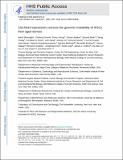ZSCAN10 expression corrects the genomic instability of iPSCs from aged donors
Author(s)
Skamagki, Maria; Correia, Cristina; Yeung, Percy; Baslan, Timour; Beck, Samuel; Zhang, Cheng; Ross, Christian A.; Dang, Lam; Liu, Zhong; Giunta, Simona; Chang, Tzu-Pei; Wang, Joye; Ananthanarayanan, Aparna; Bohndorf, Martina; Bosbach, Benedikt; Adjaye, James; Funabiki, Hironori; Kim, Jonghwan; Lowe, Scott; Lu, Chi-Wei; Li, Hu; Zhao, Rui; Kim, Kitai; Collins, James J.; ... Show more Show less
Downloadnihms946393.pdf (2.359Mb)
PUBLISHER_POLICY
Publisher Policy
Article is made available in accordance with the publisher's policy and may be subject to US copyright law. Please refer to the publisher's site for terms of use.
Terms of use
Metadata
Show full item recordAbstract
Induced pluripotent stem cells (iPSCs), which are used to produce transplantable tissues, may particularly benefit older patients, who are more likely to suffer from degenerative diseases. However, iPSCs generated from aged donors (A-iPSCs) exhibit higher genomic instability, defects in apoptosis and a blunted DNA damage response compared with iPSCs generated from younger donors. We demonstrated that A-iPSCs exhibit excessive glutathione-mediated reactive oxygen species (ROS) scavenging activity, which blocks the DNA damage response and apoptosis and permits survival of cells with genomic instability. We found that the pluripotency factor ZSCAN10 is poorly expressed in A-iPSCs and addition of ZSCAN10 to the four Yamanaka factors (OCT4, SOX2, KLF4 and c-MYC) during A-iPSC reprogramming normalizes ROS-glutathione homeostasis and the DNA damage response, and recovers genomic stability. Correcting the genomic instability of A-iPSCs will ultimately enhance our ability to produce histocompatible functional tissues from older patients' own cells that are safe for transplantation.
Date issued
2017-08Department
Massachusetts Institute of Technology. Department of Biological EngineeringJournal
Nature Cell Biology
Publisher
Nature Publishing Group
Citation
Skamagki, Maria et al. “ZSCAN10 Expression Corrects the Genomic Instability of iPSCs from Aged Donors.” Nature Cell Biology 19, 9 (August 2017): 1037–1048 © 2017 Macmillan Publishers Limited, part of Springer Nature
Version: Author's final manuscript
ISSN
1465-7392
1476-4679